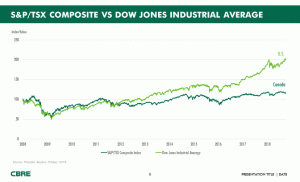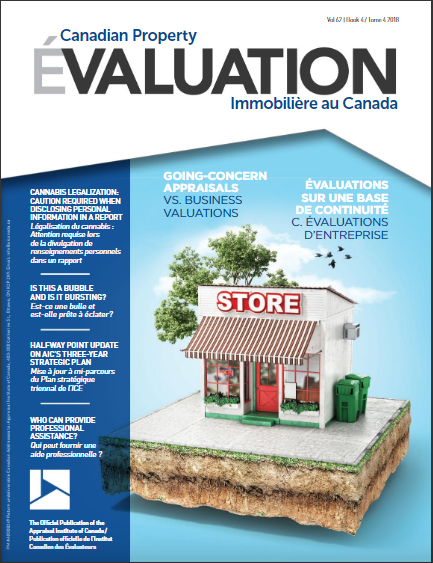Is this a bubble and is it bursting?
Canadian Property Valuation Magazine
Search the Library Online
Is this a bubble and is it bursting?
By Paul Morassutti, AACI, P. App., MRICS,, Vice Chairman, Valuation & Advisory Services, CBRE Limited
September 15, 2018 marked the 10-year anniversary of the filing for bankruptcy of Lehman Brothers, an event that many mark as the beginning of the Global Financial Crisis. With that anniversary came the obligatory reporting that we are in the midst of another asset bubble and that this cycle is ready for a downturn/recession.
The conventional wisdom can be summarized as follows: cheap debt has fuelled a stock market and real estate bubble that rising interest rates will surely bring to an end. To be even more blunt: after a decade of debt-fuelled growth, the party may be over and the hangover is just getting started.
At a minimum, that will mean increasing capitalization rates and declining commercial real estate values.
Seems like a perfectly reasonable hypothesis? Maybe it is, maybe it’s not. Let’s de-construct.
Interest rates
After a 30 year secular decline, interest rates are now firmly moving in the other direction. Rates moved up three times in 2017, twice so far in 2018 (with another likely to follow) and are predicted to go up further in 2019. The North American Free Trade Agreement (NAFTA) cloud has lifted, the U.S. economy continues its red hot pace, and global quantitative easing (QE) is being unwound slowly and cautiously. There is clearly a desire by central banks to push interest rates back to their ‘normal’ levels.
But what is normal? Is it the pre-Global Financial Crisis? If so, we have a long way to go. Here in Canada, where we have the highest degree of household debt in the G7, the Bank of Canada will have no choice but to move slowly or they risk crashing the housing market. In the U.S., the ‘sugar rush’ of the tax cuts is likely to wear off and global growth in general is expected to moderate in 2019.
Longer term, the real interest rate headwind is simply an expectation of slow growth and the main culprit in that regard is an aging/declining labour force. 2017 was the first year that the working age population declined in Canada. We are getting older, we are living longer and, therefore, our workforce faces virtually no growth. And it is a global phenomenon. Employee headcounts in Germany, Italy, Japan and Russia are also declining, with China projected to begin falling in 2024.
With labour’s contribution to GDP growth disappearing, productivity will have to pick up the slack. Technology will obviously play a large role, but there will be massive disruption along the way that will undoubtedly lead to greater income polarization.
In a world of slow growth, interest rates can only go so high.
Mitigating factors
There are a number of factors that will serve to mitigate rising interest rates that will serve the market well, even if we do hit an economic downturn. Specifically:
- Availability of capital The huge shift in ownership from highly levered private capital to well-capitalized public companies and pension funds has been well documented over the past two decades. Pension fund allocations to real estate are increasing which means billions of dollars of new capital looking to be placed. The number of REITs in Canada has grown from 2 in 1993 to approximately 50 today and new sources of foreign and sophisticated private equity capital enter Canada each year.
- Conservative use of leverage
Arguably the most important attribute when considering the health of the Canadian commercial real estate market is the relatively conservative use of debt/leverage. Most REITs are prohibited from carrying much more than 50% of debt-to-asset value, and pension funds employ an even lower percentage. Outside of the multi-family market, it is difficult to get loans at higher than 70% LTV. There are virtually no players of any consequence who are over levered, which means that, even in a severe downturn, there is little real distress amongst owners and, thus, very little forced selling. For evidence, look at the recent Alberta office market experience – vacancy levels that we have never seen before, plunging rental rates and yet no real panic selling. - Strong market fundamentals
An asset bubble is defined as a market wherein prices rise quickly and dramatically, seemingly untethered to market fundamentals. That hardly describes the Canadian commercial real estate market right now. Asset values have risen slowly over the past 10 years. Cap rates did not all of a sudden contract out of the blue, they have been slowly compressing for some time. In many markets and in many sectors, we have some of the lowest vacancy rates in North America. Rental growth, particularly in the industrial and multi-family sectors is strong. Demand – coming broadly from the technology sector and ecommerce-related logistics is expected to continue. We seem to have found the right immigration balance in this country and in this regard we are benefitting from the U.S’s nativist, inward shift. Importantly, we are much more disciplined in how we bring on new supply. Yes, there was too much office space added to Alberta at the wrong time, but that is not indicative of the broader market.
And, in cases where have seen cap rate contraction in 2018 – the industrial and multi-family sectors – the cause has been the expectation of strong rental growth, based on legitimate market factors. - Asset bubble? What asset bubble?
The classic definition of an asset bubble is noted above, and one of the reasons that it seems to be top of mind with Canadians is the amount of press that U.S. stock market performance has received lately. As of the first week of October, the Dow Jones had recorded its 14th record close of 2018. The ascent of the Dow and the S&P 500 has been almost straight up since the Global Financial Crisis and media coverage is inescapable. This alone feeds the perception of a bubble. But the Canadian experience has been more tempered. The TSX has actually had two corrections over the past 10 years and it has not reached the heights of the U.S. markets. This is hardly a bubble.

Conclusion
There is no doubt that we have experienced an extended commercial real estate cycle, and with interest rates rising and cap rates at historic lows, a case can be made that cap rate compression is officially over and, if anything, they will drift higher. I would note, however, that most (including myself) have made this prediction for the past couple of years.
It is also worth noting that interest rates are increasing on the back of inflation/economic growth, but they will ease back if the economy slows.
In short, forecasting cycles is a mug’s game. If I could do it, I would be writing this article from an island in the South Pacific. We will invariably hit another recession and it could conceivably be imminent. But the notion that interest rates will return to some type of historic ‘norm,’ pulling cap rates up with them in a meaningful way, appears unlikely when one considers everything underpinning the market.
Rather than obsess over when the next downturn will hit, I take comfort in knowing that the Canadian market is well positioned to weather it.





